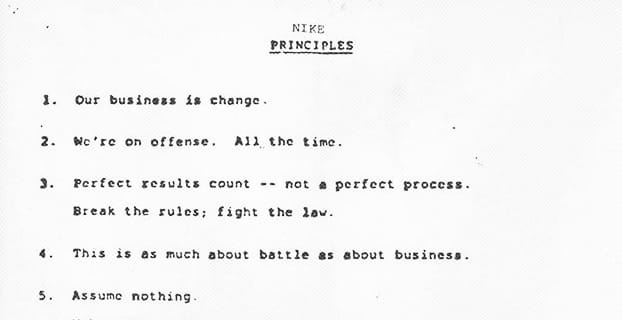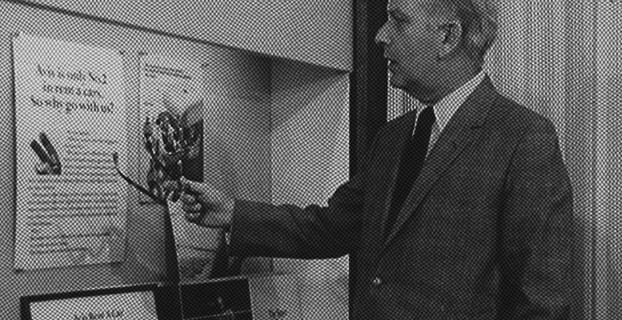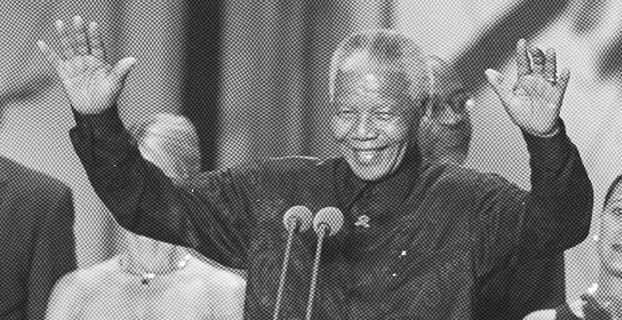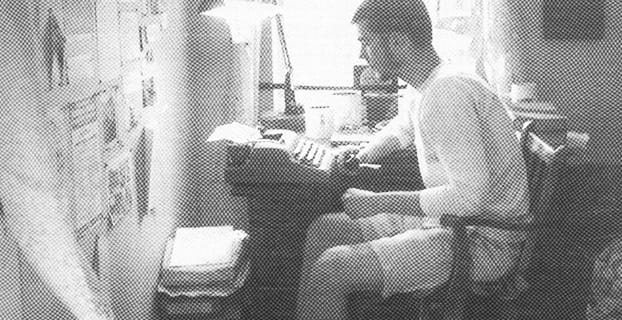
In 1977, Nike was at an inflection point.
The company, still known at the time as Blue Ribbon Sports, was growing, but it had already been kicked out of two banks and it had yet to launch its industry-shaking Air sneakers. Michael Jordan was still playing high school basketball.
Sales that year were $28.7 million. The company employed fewer than 1,000 people. It had yet to go public or become anything like the blue-chip, $46.7 billion, 79,000-employee colossus it is today.
And most importantly: The federal government had just said the company owed it $25 million for unpaid tariffs on sneakers, an amount that cofounder Phil Knight said in his memoir would have simply put the company "out of business."
Against that us-against-the-world backdrop, Nike executive Rob Strasser sat down and typed out a spirited list of 10 principles that range from "Break the rules. Fight the law." to "It won't be pretty." The list, captures the irreverence and competitiveness of early Nike employees.
Nike's 10 Company Principles from 1977
- Our business is change.
- We're on offense. All the time.
- Perfect results count — not a perfect process. Break the rules. Fight the law.
- This is as much about battle as about business.
- Assume nothing. Make sure people keep their promises. Push yourself, push others. Stretch the possible.
- Live off the land.
- Your job isn't done until THE job is done.
- Dangers: Bureaucracy. Personal ambition. Energy takers vs energy givers. Knowing our weaknesses. Don't get too many things on the platter.
- It won't be pretty.
- If we do the right things, we'll make money damn near automatic.
Nike Historian Scott Reames' Backstory
Retired Nike historian Scott Reames shared the follow backstory around these principles on LinkedIn in 2023:
Despite what you may have read recently on social media sites and Linkedin posts, Phil Knight did NOT write a set of “10 Principles” in 1980.
Oh, these 10 principles do exist (as you can see), and they were essentially the earliest precursors to what Nike now calls its “Maxims.” But they were actually written in 1977, and by Rob Strasser.
Strasser was an imposing figure during his years at Nike, both for his larger-than-life personality and his large-in-life size. And on more than one occasion, his hot temper generated what are now legendary stories, many of which would have been MASSIVE violations of HR policies today.
Strasser was a member of the law firm that Knight hired when Blue Ribbon Sports and Onitsuka sued each other for breach of contract. After the trial ended in a victory for BRS in 1974, Strasser left the law firm and joined the company that was transitioning into Nike. Over the next dozen years or so, he would become a major force for the company’s growth, and his passion would sometimes get the better of him.
Case in point: a day in 1977 when Strasser was purportedly in a fit of pique that employees were losing sight of the company’s values. He stormed into his office and pounded out on his typewriter what became a list of 10 bullet points that he felt were the central core of who/what Nike was. He slammed the sheet of paper on the copying machine, made dozens of duplicates and then taped them on office doors and put them on cubicle desks all over the building.
As you can see in the original document (note: unlike what is circulating online, it did NOT have a wispy Swoosh at the top), some of these “principles” remain as relevant today as they were 46 years ago, while others didn’t age as well. It’s important to remember the context of the company that Nike was in 1977. Technically, it was still Blue Ribbon Sports; Nike, Inc. didn’t come along until 1978.
There was no Nike Air yet… that would also debut in 1978. Most of the company’s R&D was taking place in Exeter, NH, and the Nike Sport Research Lab was not yet launched. Steve Prefontaine had died just two years earlier and John McEnroe was not yet signed. The company was grappling with a potential US tariff that could cripple, or even close the business. And Nike wouldn’t even go public until three years later, in December of 1980.
Indeed, even though the Waffle Trainer and Waffle Racer were successful, Nike was still far from a sure thing to become the international phenomenon we all know today. I can’t speak for Strasser, since he died long before I assumed the role of historian, but I have to imagine many of these thoughts swirled through his mind as he assaulted his typewriter that fateful day in 1977.













